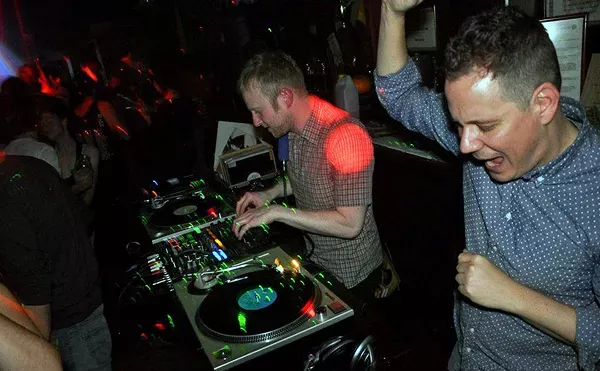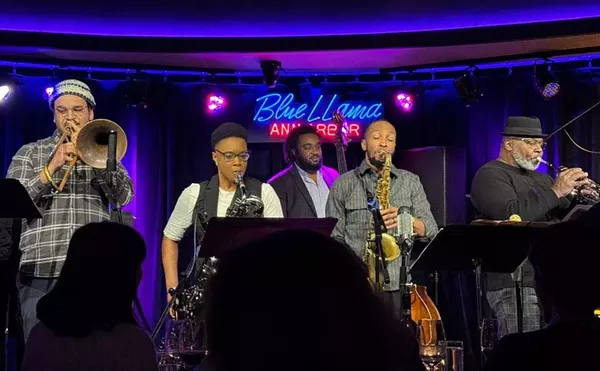Hakim Jami, the leader of the Street Band, lugs his bass onto the small stage at the Detroit Art Space. Saxophonist Skeeter Shelton, dressed in a beige work vest and a black skullcap, escorts his father, the drummer Ajaramu, onto the bandstand. The 72-year-old trapsman settles in behind the kit. He pulls drumsticks from his hip pocket, and places them on his lap. The man’s ready to swing.
At center stage, Shelton positions himself next to the group’s trumpeter. They press their horns to their chests.
Jami props the stand-up bass against his shoulder, and starts the first set with a tune of his, “Give the Horn Player Some.” The man plays with such aplomb that the bass seems to take on a life of its own. Jami could have left the bandstand and the bass would have played itself. By the end of Jami’s solo, Shelton steps forward and adjusts the mouthpiece on his sax. He’s ready to blow. Before organizing the right combination of notes, the ones that propel him into a kind of improvisational bliss, Shelton dissects the song’s melody. He blows so forcefully his horn appears to be on the verge of exploding.
“Some of the our music is avant-garde, and some of it is straight ahead like ‘Forrest Dancer,’ the tune Skeeter wrote for his daughter,” Jami says later. “We like to play at venues where we can play our own tunes.”
Jami is referring to the Detroit Art Space, a small art gallery connected to a large club space that artist Mildred Thibodeaux and her son Don opened last December. Since then, it has become a haven for avant-garde jazz bands such as the Street Band, Lincoln Street Reunion Band, Soul Rhythm with Faruq Z. Bey, Immigrant Suns Orchestra, Bostonians and Slavic Soul Party.
“Not everybody is going to the casino to listen to the lounge lizard stuff,” says Don Thibodeaux. “Detroiters have an appetite to be entertained. No matter what it is. It can be hockey, basketball, opera or jazz. Show Detroiters what’s going on and they will be there.”
In a way, the Thibodeauxs have brought back “loft jazz,” not so much a style as a musical attitude popular in New York, Boston and Chicago during the 1970s. It was very DIY in that the avant-garde players formed their own music community — creating venues out of loft spaces — primarily because mainstream jazz clubs shunned them.
“This form of music has been overlooked in Detroit,” explains saxophonist Faruq Z. Bey. “There have been some powerful people playing here, a whole stream of cats.”
Accomplished musicians such as Bobbie Battle, Leon Henderson, A. Spencer Barefield, Charles Eubanks, Jaribu Shahid, Tani Tabbal and Ali Jackson all were key figures of Detroit’s free-jazz culture during the 1970s and 1980s.
These free-jazz musicians always had a tough time finding venues that would feature their brand of music. During the 1970s, Cobb’s Corner in the Cass Corridor hired free-jazz bands such as Griot Galaxy for weekend gigs. From 1979 to 1992, guitarist A. Spencer Barefield’s creative music series at the Detroit Institute of Arts showcased a variety of cutting-edge ensembles. The outcats have found other niches over the years, but never enough.
Round the horn
These days, mainstream and mainstay Detroit clubs such as Baker’s Keyboard Lounge, Bert’s Marketplace, the SereNgeti East and the Harlequin Café work varied formulas.
At SereNgeti East — located in the Samaritan Center on Conner near Warren — owner (and tireless jazz promoter) Bill Foster periodically presents nationally renowned musicians such as saxophonists Teddy Edwards, and Charles McPherson. In April, Charles McPherson — a bebop master and former sideman for bassist Charles Mingus — played a weekend engagement. He worked hurricanelike gusts from his alto; the SereNgeti audience virtually had to hold onto their tables to keep from blowing over.
The much-storied Baker’s Keyboard Lounge has been a hub for jazz in Detroit’s since opening in 1934. During its heyday in the 1960s and 1970s, legends such as Sonny Stitt, McCoy Tyner and Lee Morgan graced the bandstand. Today, Baker’s serves up the best in local jazz. Each night the venue has a different vibe. When the Dwight Adams quartet (featuring saxophone wunderkind Dean Moore II) performs, the club feels like a hard-bop revival meeting. On other nights, the amazing voices of Panthea Hawes and Joy Temple turn Baker’s into a Kansas City-style juke joint. On jam-session nights, it’s a bebop battleground where old cats and young hipsters joust.
Typically, folks go to Bert’s Marketplace in Eastern Market either to hear saxophonist Larry Smith or for the Wednesday night fish fry. Smith’s bluesy and soulful bop stylings stick to you like barbecue sauce. But, more than a year ago, vocalist Dee Dee McNeil made Bert’s a hot spot for jam sessions, with a particular openness to vocalists. Though McNeil has headed off to California, her backing trio continues the Thursday night tradition. Drummer Spider Webb, pianist Bill Meyer and bassist Hubie Crawford have become the tightly knit SBH Trio, ready to take the music where the cats on hand point. Keeping the vocal orientation, they now recruit vocalists — Bob St. Thomas for July — to host and anchor proceedings.
The swanky Harlequin Café is on Agnes, next to the lofty Parkstone Apartments. From the outside, you can see the house piano, customers sipping top-shelf booze and the chef organizing the buffet table. The Harlequin is aesthetically pleasing, sure, but it’s not always the best place to listen despite the bandstand talent. One night in May, for instance, pianist Rick Roe and trombonist Wycliffe Gordon performed duets to recurring disruptions; at one point, a waitress interrupted Gordon’s introduction of “Sophisticated Lady” to announce that the buffet was open. An evidently miffed Gordon rushed through the tune, placed his trombone against the piano, and got in line. During the second set, Roe’s “Prelude to a Kiss” solo was drowned out by the espresso machine. Sometimes jazz has those nights.
Shunned
On the surface, Detroit’s jazz community appears to be tightly knit. Some musicians will tell you otherwise
“They have cliques here,” ventures Jami. “If you don’t belong to the clique you don’t work. I never belonged to one. When I moved back to Detroit from New York, I couldn’t go to another musician and get a roof over my head. When a cat goes to New York they are covered. Musicians in New York have a real community.”
Shelton recalls a disheartening episode when his band tried out for a gig at Baker’s: “When we started playing the owner turned on the jukebox. In these clubs, all they want to do is play those old tunes. Even my dad says they’re still playing tunes that was around before he started playing music. … Anybody can play ‘Tracks of My Tears’ on the saxophone; that’s smooth jazz. Where is the ‘real jazz’? Why aren’t they playing tunes by Eric Dolphy, Jackie McLean, Rahsaan Roland Kirk and Gene Ammon?”
Johnny Colbert, a co-owner of Baker’s, admits that the jazz community has factions, and he says he doesn’t have a beef with free jazz. But people go to Baker’s to hear mainstream acoustic jazz, he insists.
“The avant-garde style of jazz has not been well-received here. I try to maintain the bop and swing kind of jazz that made Baker’s legendary and a world-class club,” he says.
Swinging forward
The argument over what constitutes “real jazz” will go on forever. What’s important is whether the audience has choices. Detroit will continue to be a bebop town. Yet, the emergence of the Detroit Art Space is an indication that the scene is becoming more diverse.
“The scene is improving from where it was, say, 10 or 15 years ago,” says Bey. “It has more diversity. The state of the audience is such that musicians can produce what they really feel instead of being forced to adhere to some traditional attitude.”
Charles L. Latimer writes about jazz for Metro Times. Send comments to [email protected]





